When US Secretary of State John Kerry visited Moscow in March, looming over his meeting with Russian President Vladimir Putin in the Kremlin was a statue of Russian Emperor Alexander II (1855-81). Known as the ‘Tsar-Liberator’, Alexander freed the serfs, introduced trial by jury, relaxed press censorship and created elected regional assemblies that might, but for his assassination, have laid the foundation for bolder constitutional experiments.
But isn’t Alexander the wrong autocrat? Russia, we are told, is in the grip of Stalin-mania. Over the past 12 months,The New York Times, The New Statesman, The Independent and Foreign Policy have reported on an unspoken Kremlin policy to rehabilitate the Soviet tyrant.
Dubbed ‘re-Stalinisation’, its alleged aim is to return Russia to the fear and suspicion that characterised life until Stalin’s death in 1953 and to secure what are asserted as having ever been Putin’s twin goals: the consolidation of absolute personal power and restoration of the Soviet Union (or something like it) in Eastern Europe.
Appearing to support such dark tidings, a survey from the Levada Center (an independent polling organisation) earlier this year showed a significant rise during Putin’s presidency in the number of Russians who believe Stalin’s time in power ‘brought with it more good than bad’, from 26% in 1999 to 40% in 2016.
Also serving as evidence of a Kremlin-directed revival of the Stalin cult and, by extension, of Putin’s own Stalin-esque ambitions is a handful of recent provincial monuments raised in Stalin’s honour, mostly at the initiative of the opposition Russian Communist Party. Others fault the Kremlin’s failure to suppress the popular use of Stalin's image during last year’s 70th anniversary celebrations of Soviet victory in the Second World War.
But does the evidence really support the phenomenon such commentators believe they see?
Not according to Mikhail Remizov, director of the National Strategy Institute.
‘It is absolutely not the case’, says Remizov, ‘that there’s any official programme for rehabilitating the Stalin cult from above. It’s a popular movement, driven from below, propelled by a sense of anger towards what is perceived to be a vast trahison des élites.’
Motivated by a desire to cut the country’s oligarchs down to size, popular nostalgia for Stalin offers an implicit challenge to what has from the start been a central element of Putin’s legitimacy: his claim to have ‘tamed the oligarchs’.
Despite his public image, says Remizov, Putin isn’t a Vozhd (‘Leader’, a popular name for Stalin) before whom Russia’s ruling elite trembles; he’s an (imperfect) moderator of their squabbles.
‘Putin isn’t even a Stalinist in the good sense’, says Remizov, with irony. ‘He can’t fully discipline his own system. To defeat the Stalinist myth, you need to solve the problems Stalin solved with violence with non-violent means. And the present system cannot yet do that.’
Official treatment of Stalin reflects the result of this impasse, neither to suppress nor promote popular support for his legacy.
But if the Kremlin isn’t trying to revive Stalinism, what is going on?
Absent from Western reports of ‘re-Stalinization’ is the evidence for a much wider shift in Russians’ views on their country’s history. Particularly striking has been the rehabilitation of the pre-revolutionary regime. The same survey that showed an increase in favourable perceptions of Stalin also revealed that since 1999 the number of Russians believing the reign of Nicholas II (1894-1917), Russia’s last tsar, ‘brought more good than bad’ had risen from 18% to 30%. Also, the number believing the 1917 Revolution to have been a good thing fell from 27% in 1999 to 19% in 2016, while those believing it to have been for the worse rose from 38% to 48%.
The shift is reflected in Russian public space. With communism having withered, the contours of an older Russia have re-emerged.
On the banks of the Moscow River, in the gardens of the restored Cathedral of Christ the Saviour (consecrated in 1883 as a monument to Imperial Russia’s 1812-14 victory over Napoleon but demolished by Stalin in 1931), a six-metre bronze statue of the ‘Tsar-Liberator’ Alexander II enclosed by a half-circle marble colonnade of Doric columns was unveiled in 2005.
Unthinkable 25 years before, in 2013 an obelisk originally erected in 1914 outside the Kremlin walls was cleansed of its Soviet-era transformation into a monument to the workers’ struggle, and rededicated to its original commemoration of the Romanov tercentenary (1613-1913), Imperial Russia’s last great national celebration.
By the time of the dynasty’s 400th anniversary celebrations, monuments to Russia’s last tsar, Nicholas II (1894-1917), and his pious father Alexander III (1881-94, formerly reviled as executioner of Lenin’s brother, a revolutionary) had appeared from Russia’s Baltic to Pacific coasts.
If there's a Russian leader whose reputation has been unequivocally rehabilitated during the Putin era, it's Nicholas II. Known during communist days as 'the Bloody', Nicholas is now more commonly known to Russians as the 'Tsar-Martyr'.
Since Nicholas and his family were sainted by the Russian Orthodox Church in Russia in 2000, churches, chapels and shrines dedicated to the so-called 'Holy Imperial Martyrs' have appeared across Russia.
In conformity with Orthodox practice, icons (devotional images) of these sainted Romanovs are for sale in a variety of poses, from mass-produced laminated cards to lavish diptychs housed in soft red velvet cases. Their former palaces and places of exile and execution have become pilgrimage destinations. A hundred years next year since the 1917 revolution, public memory has turned full circle. Where Russians were once encouraged to repudiate the Romanovs as 'oppressors of the people', today they're encouraged, quite literally, to worship them [Of course, we cannot agree with nor endorse this exaggeration—O.C.].
Inside Moscow's Christ the Saviour Cathedral, an icon of the 'Imperial Passion-bearers' romanticises life at Russia's pre-revolutionary court: Nicholas II and his son, Alexei, wear military uniform; the Empress and her daughters elegant dresses.
On the other side of the nave, the magnificent icon of the 'Assembly of the New Russian Martyrs and Confessors' depicts Nicholas, Alexandra and their five children at the centre of a mass of bishops, priests, monks and nuns martyred by the Communist government between 1918 and 1941.
To the family's left stands another sainted Romanov, the Grand Duchess Elizabeth, who, after being widowed by Socialist Revolutionaries in 1905, founded a home for poor women and children on Moscow's south bank. She too was executed by the Bolsheviks in 1918.
Along with those of a dozen other bishops and monks, their deaths are depicted, almost cartoon-like, in a cycle of smaller images that form a border around the edge: Bolshevik soldiers gun the Tsar and his family to death, while others cast Elizabeth down a mineshaft (earlier this year the State Historical Museum on Red Square staged a four-month special exhibition on Elizabeth's life, a joint project between the Moscow Patriarchate and Ministry of Culture; the home she founded has now re-opened, embellished with a sculpture of the Grand Duchess).
Then there are the books.
Parish churches offer a range of devotional literature: The Childhood of Nicholas II; 'Give Them Love' – The Words of Empress Alexandra; The Imperial Children; The Charitable Causes of the Romanov Family. For sale in Moscow and St Petersburg bookshops are titles of a more overtly political nature: The Emperor Who Knew His Fate and Russia, Which Didn't; Emperor Nicholas II and the Plot of 1917; 'Surrounded by Treachery, Cowardice and Deceit' – The real story of the abdication of Nicholas II; 'Lord, Bless My Decisions' – Nicholas II as Commander-in-Chief and the Generals' Plot, et cetera, et cetera.
But does such idealised veneration reach as far as the Kremlin?
On a sunny afternoon in Moscow I meet a well-connected former editor of a Moscow daily.
'Putin doesn't want to be seen as merely continuing the USSR', he says. 'The Soviet Union failed and for him that indicates that there was something wrong with it.'
Putin, he says, 'isn't interested in being remembered as some kind of Communist Party general secretary. He thinks of himself as a Russian De Gaulle or a Franco', head of a self-consciously 'transitional regime' aimed at restoring a semi-traditional political and social order.
That may even include the monarchy.
'The return of the Romanovs would be part of his historical role, a way of knitting the country's history together again, of declaring that at last the revolution is over.'
He claims he was once present when Vladimir Zhirinovsky, the firebrand nationalist that heads Russia's Liberal National Democratic Party, compared Putin to Franco in Putin's presence. The Russian president didn't object.
'The problem is with the dynasty.'
With all of Nicholas's children perishing with him in a hail of Bolshevik bullets in 1918, no legitimate successor is acknowledged; the various Romanov contenders are ferociously divided (both leading claimants have recently visited Crimea to support Russian claims to the peninsula and, cynics will argue, their own to a future throne).
'What's needed', he says, 'is a new zemsky sobor', referring to the 16th and 17th century assemblies that advised the Tsar on subjects of pressing national importance and which most famously, in 1613, elected the first Romanov tsar.
Could Putin really be planning a restoration of the Romanovs?
Of Putin's three 'favourite' philosophers (Vladimir Solovyov, Nikolai Berdyaev and Ivan Ilyin) it's Ilyin who is thought to have exercised the greatest influence over Putin's understanding of Russia's political and spiritual history.
In his best-known work, Our Tasks, Ilyin depicts all of Russia's 20th century woes (its descent into tyranny, its economic collapse, its cultural and spiritual ruin) as flowing flow from the Tsar's abdication. Seeing the essence of what he calls Russia's 'national legal self-awareness' to rest on 'two foundations, Orthodoxy and faith in the Tsar', Ilyin asks why that self-awareness failed in 1917 and what can be done to repair it.
'The obligation rests upon us', he writes, 'on this generation of Russian people who have suffered this revolution with sorrow and torment, to ask ourselves wherein the essence of healthy, strong and deep monarchical legal consciousness consists and how to replant it in Russia.'
Certainly, Putin's views have moved in step with Russians' changing perceptions of the 1917 revolution. When in January of this year he reproached Lenin for errors of moral and political judgement during and after the Revolution, he provoked rage among Russia's remaining Communists.
'Everyone accused the tsarist regime of repressions', he said. 'But what did Soviet power begin with? Mass repressions.'
Of these, he said, 'the execution of the Tsar's family together with his children' was the 'most outstanding example' (one wonders whether he had the icon of the 'New Russian Martyrs' in mind).
Certainly, Putin has come to see it as part of his legacy as president to 'restore the links of time, the unbrokenness of [Russia's] history', as he put it when in August 2014, he dedicated Russia's first memorial to the dead of the First World War, written off in Soviet times as an inglorious imperialist venture.
But when it comes to Russia's public memory, the Kremlin shares power with the Russian Orthodox Church, a critical voice in any future zemsky sobor. Indeed, it was the Patriarchate that last year frustrated the government's plan to rebury the remains of two of the Romanov children alongside those of their parents in the Imperial mausoleum, lest it stir undue controversy among the many Russians still nostalgic for Soviet days.
Vakhtang Kipshidze, a Patriarchate spokesman, cautioned against any perception that the Church was looking for a restoration.
A 'political struggle', he said, was 'not on the Church's agenda'. The goal instead was spiritual, what Patriarch Kirill in a 2015 address to the Duma called 'historical reconciliation'.
Central to this project have been the three 'My History, Orthodox Rus' national historical exhibitions staged annually in Moscow's Manezh Exhibition Center under the joint aegis of the Patriarchate and Ministry of Culture since 2013, when the first opened in honour of the Romanovs' 400th anniversary.
Each attracted around half a million visitors in Moscow before touring the country. They're now permanently if incongruously housed in a brand-new building in the dated, Soviet-era surrounds of Moscow's All-Russia Exhibition Park. A portrait of Alexander III flanks the entrance.
In the spirit of the times, advertisements in the Moscow metro bear the famous riposte of Peter Stolypin (Nicholas II's liberal conservative prime minister and a known Putin 'hero') to anti-tsarist deputies in the Duma: 'You, gentlemen, are in need of great upheavals; we are in need of a Great Russia.'
To be sure, this is an essentially conservative project. But 21st century Russia resembles more the conservative, but ultimately limited, authoritarianism of the last Romanovs than the industrialised totalitarianism of the Soviet Union (with its goal of worldwide Marxist-Leninist revolution). Like the tsars, Russia's ruling caste today seeks to control a programme of modernisation based on the selective imitation of the West. Though the government is hostile to competitors for political power, the Soviet-era ambition of absolute control over Russians' thought and economic lives is foreign to it.
What might all this mean for Western policy?
Talk of a 'New Cold War' has made it commonplace to cast Putin's Russia as a neo-Soviet power in deluded search of vanished global superpower status, an aspiring and implacably anti-Western hegemon in Europe, and an imminent threat to Western democracy. It has fuelled calls for NATO to embrace a policy of 'Containment 2.0' (as the Alliance effectively did at its recent Warsaw summit).
But rethinking the sources of Russian behaviour possibly changes this picture.
Between 1613 and 1917 the Romanovs transformed a remote and backward principality on Europe's periphery into a leading power not in opposition to, but within the European state system. There's a good argument that what Moscow wants today is not a return to the superpower confrontation of 1947 to 1989, but a version of the 'European concert' of 1815 to 1914.
Thus, unveiling in 2014 a bronze statue of Emperor Alexander I (1801-25) in the shadow of the Kremlin wall (pictured above), Putin hailed the tsar who defeated Napoleon as a 'farsighted strategist and diplomat, a statesman' who created 'the conditions for a so-called balance, built not only on a consideration of countries' mutual interests, but also of moral values.'
We needn't take this at face value. Alexander was inspired more by a vision of Christian universalism than realism. But as a statement of present-day Russia's aims, it's consistent enough. In the face of NATO expansion, re-establishing such a balance has been a theme in Russian foreign policy for well over a decade.
Finally, there's the question of the succession – to Putin. His present term ends in 2018, the centenary of Nicholas II's murder. Nobody knows for sure whether he'll run for president again (he has left open the possibility that he might not).
But absent a single legitimate heir, Russian monarchists are remarkably fond of observing that, should it ever come to a zemsky sobor, nobody says Russia's next tsar must be a Romanov.

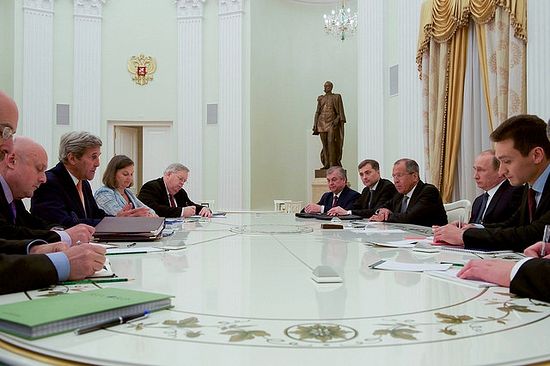
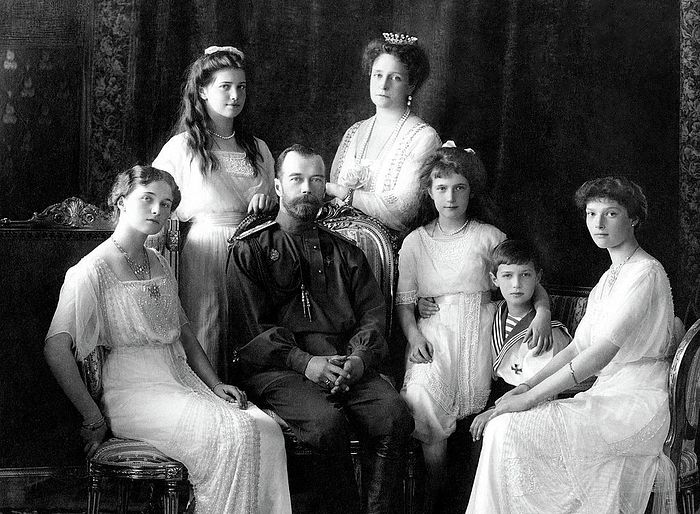
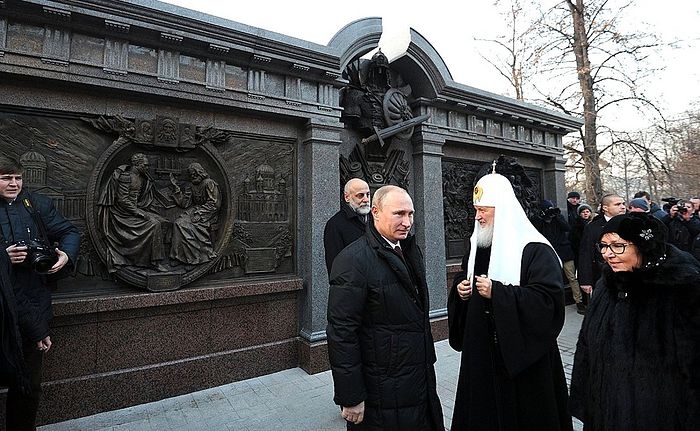
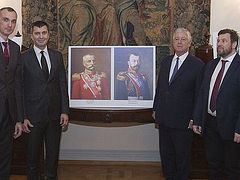
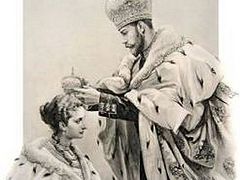
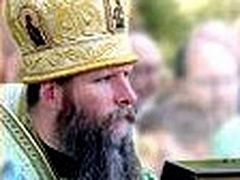
I have dream the russian be the 1 economie in the world... God blesses
Putin's attitude us that all past Russian leaders should be honoured, first and foremost because they are part of Russia's history. Therefore, without ignoring their mistakes, efforts should be made to remember them for what they did well.
Thus, Alexander defeated Napoleon.
Stalin was a tyrant (Putin's own words) but he defeated Hitler. This should be remembered, especially in these days when the West would gladly equate Stalin with Hitler.
Gorbachev may have made mistakes , but he did "something I don't think I'd have dared to do..." (G. being still alive, Putin won't say anything to offend him, but perhaps this "praise" is somewhat ambiguous...)
And, watching Putin's address at Yeltsin's funeral, one sees that he did find something to praise in him.
The issue is therefore not restoring the Romanov at all, but making sure the Russian people have a balanced view of their history - even dark times had some silver lining.
Orthodox worship God alone. The verb the author should have chosen is VENERATE.
This regrettable error spoils what seems otherwise to be a very good article.